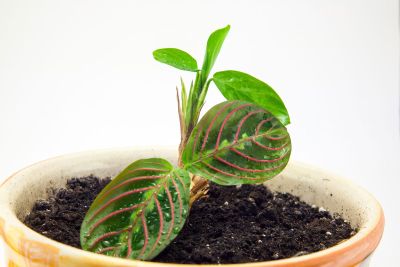About Red-Veined Prayer Plants
A tropical plant native to Brazil, red prayer plant is a popular and attractive houseplant. Its scientific name is Marantha and the variety is ‘Erythroneura,’ which means red veins in Latin. The red veins are in a herringbone pattern, giving rise to another of the plant’s names: herringbone plant. In warm climates, it forms a ground cover while in cooler regions it is best used as a hanging indoor plant. The Maranta plant is a prostrate evergreen species that rises from rhizomes. It grows 12-15 inches (30.5-38 cm.) tall. The beautiful foliage is broadly oval and features 5-inch (12.5 cm.) long olive-green leaves with prominent red midribs and veining in a herringbone design. The center of the leaf is a lighter green and the undersides are even lighter still. The best thing about the plant is its ability to “pray.” This is called a nastic movement and is the plant’s response to light. During the day the leaves are flat, but at night they move upward as if praying to the heavens. This also allows the plant to conserve moisture at night.
Caring for a Red Prayer Plant
Maranta species are tropical and live in understory areas of the forest. They need moist soil and dappled light to shade. They thrive in temperatures of 70-80 F. (21-27 C.). In cooler temperatures, the plant will refuse to pray, the colors will not be vibrant, and some leaves may even wither, brown, or fall off. Very bright light will also affect the colors of the foliage. A northern window or in the middle of a semi-bright room will provide enough light without reducing leaf color. The plant’s water needs are very specific. The soil must be consistently wet but never soggy. A moisture meter is an essential part of red prayer plant care. Fertilize with a diluted houseplant food in spring.
Red Prayer Plant Problems
If grown as a houseplant, Maranta has few disease or pest issues. Occasionally, fungal issues can arise on the leaves. To avoid this problem, water under the leaves directly onto the soil. Ensure well-draining soil to prevent root rot and fungus gnats. A good mixture is two parts peat moss, one part loam, and one part sand or perlite. Outside, common pests are mites and mealybugs. Use horticultural oil sprays to combat. Red-veined prayer plant prefers to be pot-bound and should be in a fairly shallow pot due to its shallow root system. If leaves become yellow at the tips, they could be from excess salts. Put the plant in the shower and flush the soil with water and soon it will produce healthy new leaves.
